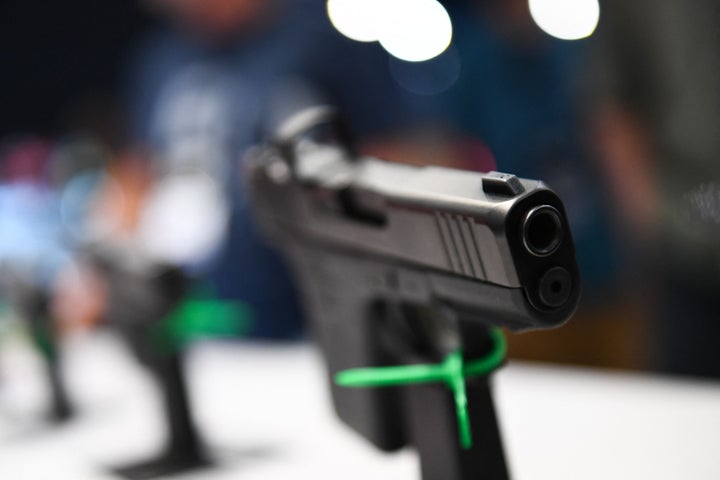The Supreme Court should guarantee gun rights for an accused domestic abuser, several Second Amendment defenders finally wrote in court filings last week.
The Second Amendment movement had not, to date, voiced much public support for Zackey Rahimi’s cause. But the amicus filings offer a window into gun groups’ thinking on the questions posed by USA v. Zackey Rahimi, which promises to define how the Court will interpret the right to bear arms in the coming years, and specifically whether laws banning domestic abusers from gun possession are constitutional. The Court will hear oral arguments in the case next month.
The Supreme Court’s last three major decisions to expand gun rights all emerged out of civil court cases brought by law-abiding firearm owners and an advocacy group.

PATRICK T. FALLON via Getty Images
Rahimi, on the other hand, features a potentially unsympathetic defendant accused of repeatedly shooting guns at people, into houses, at cars, and into the air.
In addition to the alleged domestic violence against his former partner, with whom he has a young child, Rahimi faces felony prosecutions in Tarrant County, Texas, for aggravated assault with a deadly weapon against three separate people, recklessly discharging a firearm and possession of fentanyl.
He publicly discharged firearms at least six times, including repeatedly shooting at a separate young woman he lured into a parking lot, according to court filings and police records obtained by HuffPost. After landing in prison to face his state criminal charges, he attacked a prison guard, according to an incident report.
Those allegations are beside the point, says a filing submitted by nine gun rights groups.
“The Government focuses on the alleged criminal activities of Mr. Rahimi, with five pages of detailed facts, conflating his alleged felonies with his entirely unrelated disarmament based on a civil order,” the filing reads.
No matter how unsympathetic Rahimi is, gun owners should not be stripped of their Second Amendment rights without first convicting him of a crime with a high standard of evidence, the groups say.
“Rahimi should not only lose his Second Amendment liberties, but he should also lose all of his liberties ― if the allegations against him are ultimately proven true with sufficient due process,” the NRA’s filing reads. “But constitutional safeguards cannot be set aside to obtain those ends.”
Both filings downplay the legitimacy of many protective orders, with the 9-group coalition saying, “the Government desires the power to disarm untold thousands of Americans subject to civil protective orders, which are based on all manner of marital or relational discord.”
Setting that high of a standard to disarm an alleged abuser would mark a seachange in U.S. law.
People facing domestic abuse can access two broad types of court orders to protect themselves — temporary restraining orders that don’t require a judge to sign off, and longer-term protective orders issued by a court.
They typically are issued though civil processes rather than criminal ones and neither requires proof “beyond a reasonable doubt,” the high standard used to mete out criminal convictions that can result in jail sentences.
Congress made it a felony to possess a firearm while subject to protective order for domestic violence in 1996. The law survived constitutional challenges for nearly three decades. Several states go further than that, barring firearm possession for people subject to a temporary restraining order.
Measures that bar abusers from easily accessing firearms have a research-backed record of shielding victims and survivors of domestic violence from their tormentors. Gun reformers, advocacy groups and public health researchers say current laws don’t go far enough.
But the Supreme Court, with a lopsided conservative majority inherited from the Trump administration, issued a sweeping reinterpretation of the Second Amendment last year, making long-standing gun safety laws newly vulnerable to constitutional challenges.
The decision in New York State Rifle & Pistol Association, Inc. v. Bruen, penned by Justice Clarence Thomas, said that neither state nor federal government could weigh public safety concerns anymore when considering the constitutionality of firearm restrictions.
Instead, courts would have to judge whether a given gun restriction had a historical tradition dating back to some time between 1791 ― when the Bill of Rights passed ― and the end of the Civil War.
The ruling spurred chaotic enforcement, with courts across the country issuing competing rulings about the constitutionality of long-standing gun safety measures and dissuading state legislators from passing new laws.
Rahimi’s case is the first that the Supreme Court will take since issuing the landmark ruling last year.
Gun groups say the federal government can’t come up with the “historical analogs” that the Supreme Court now demands.
Domestic violence was “not taken as seriously as it should have been for much of the nation’s history,” the NRA filing notes.
When the government did try to disarm certain classes of people historically, it often did in flatly discriminatory ways that would not be considered constitutional now. In the early years of the Republic, for example, some states barred Black people or Native Americans from possessing firearms.
Reformers and researchers have also wondered how the Supreme Court will approach that issue when they reconsider it.
Colonial and early republic authorities only occasionally punished people for battering their spouses. Punishments might include fines or whipping, and routine offenders might have to post a bond to avoid jail time, but courts did not typically disarm them.
The movement that led to modern laws criminalizing domestic violence only gained steam in the late 19th century, likely putting it outside the scope of the Bruen decision.
The “Government seeks to turn Americans who have never committed a felony into felons based on their mere act of possessing a firearm, and claims to justify this with historically unsupportable rationales,” the coalition filing says.

